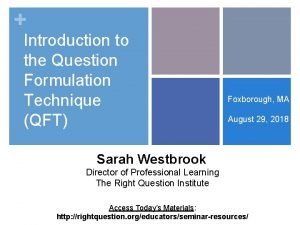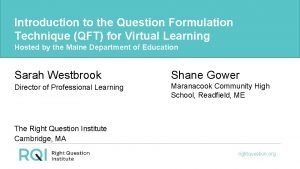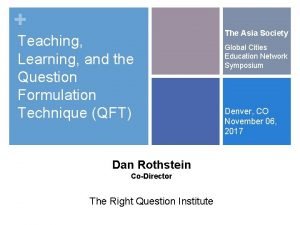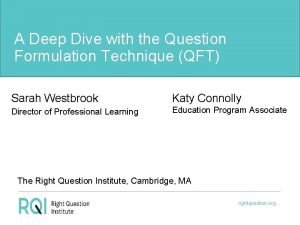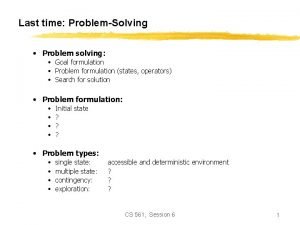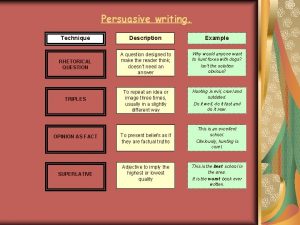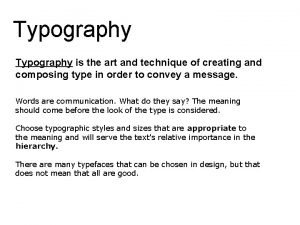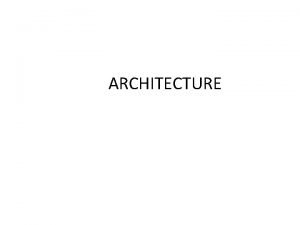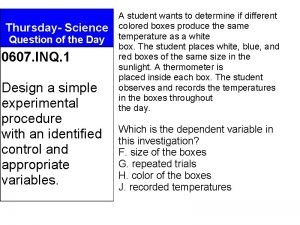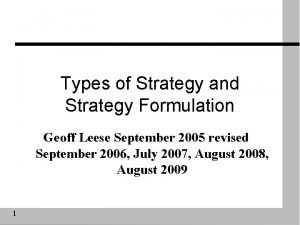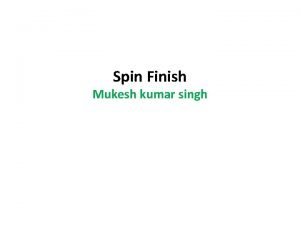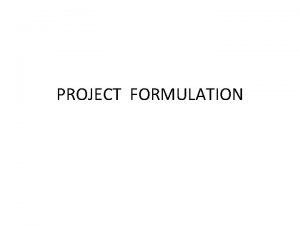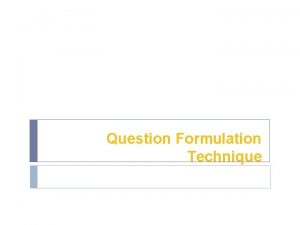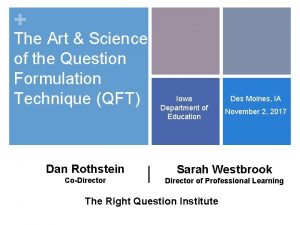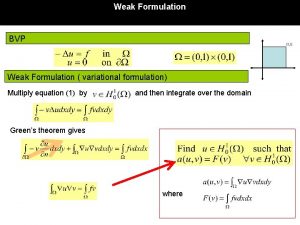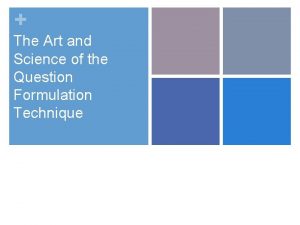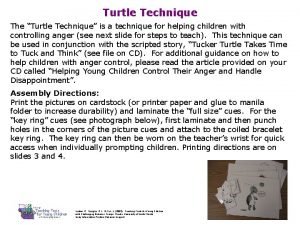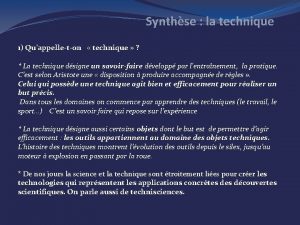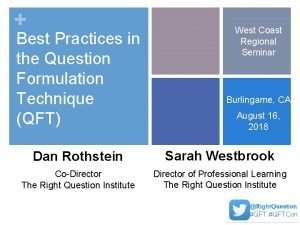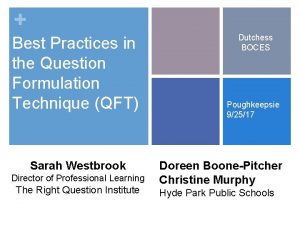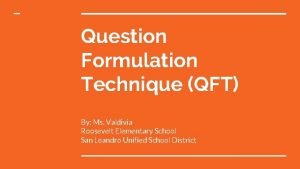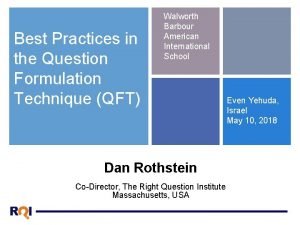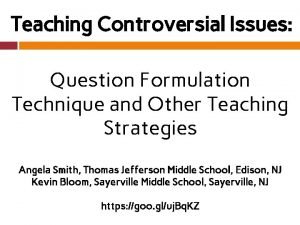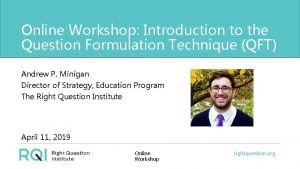The Art Science of the Question Formulation Technique































- Slides: 31

+ The Art & Science of the Question Formulation Technique (QFT) Dan Rothstein Co-Director Chicago Public Schools | Chicago, IL November 4, 2017 Sarah Westbrook Director of Professional Learning The Right Question Institute

+ Today’s Agenda 1) Welcome and Community Building 2) Collaborative Learning with the Question Formulation Technique (QFT) 3) The Art and Science of the QFT 4) Lunch 5) Question Focus Design Workshop 6) Self-Organized Working Groups 7) The QFT in Action #QFTCon #QFT

+ To Access Today’s Materials: http: //rightquestion. org/educators/ seminar-resources/ Join our Educator Network for: Templates you can use tomorrow in class § Classroom Examples § Instructional Videos § Forums and Discussions with other Educators §

+ Four Principles of Facilitation 1. Monitor student adherence to the process 2. Do not give examples 3. Do not get pulled into group discussion 4. Acknowledge all contributions equally ØDiscuss: What could be challenging about each principle? What might be important about each?

+ Work with a Lesson Planning Workbook As you begin work, consider: n What seems helpful or useful about this planning tool? n What’s missing? What parts need further clarification or support?

+ QFT: An ART and a SCIENCE The Science: A rigorous protocol, with specific steps and sequence, that produces consistent results The QFT 1. Discuss the rules 2. Present a Question Focus 3. Improve questions 4. Prioritize questions 5. Discuss next steps 6. Reflect

+ QFT: An ART and a SCIENCE The Art: Tailoring the QFT process to the specific content and students you are teaching. Tailor the QFT through: n. Design of the Question Focus (Qfocus) n. Instructions prioritizing for n. Next steps for using the questions n. Reflection questions n. Facilitation

+ Five Areas Related to the Art of the QFT 1. Facilitation 2. Linking the QFT to Teaching and Learning Goals 3. QFocus Design 4. Prioritization Instructions 5. Reflection Questions

+ The QFT as a Shortcut, Not a Detour

+ Various Teaching Purposes n. Engagement n. Knowledge n. Formative acquisition assessment n. Summative n. Peer n. Skill assessment review development

+ Using the QFT for Engagement

+ Next Steps with Student Questions The Driving Question Board v v. The “Parking Lot” v. Ongoing student choice projects

+ Using the QFT for Peer Review Scientist’s claim: “Adding a dam to a water system causes a decrease in aquatic life downstream. ” Student Design to test the claim:

+ Next Steps with Student Questions:

+ Using the QFT for Skill Development (Students were assigned a complex molecular biology article) QFocus: Ask as many questions as you can about the reading

+ Next Steps with Student Questions: v Students generate questions as homework then bring in to class v Students discuss key attributes of a good biological research question and compare to other types of questions v Students form groups and improve their questions, based on these attributes v These questions are discarded or kept in notebooks (up to the student) v Students apply this skill to designing their own research project later in the semester

+ Various Teaching Purposes n. Engagement n. Knowledge n. Formative acquisition assessment n. Summative n. Peer n. Skill assessment review development

+ Pop Quiz or Reading Check Next Steps? Debate Prep Lab work & Experiments Paper topic Exit ticket or ”Do Now” Research Hang on walls, Check Off as Answered Projects Test Prep Homework Class discussion prompts And sometimes… Presentations Socratic Seminar Prompts Student Choice Projects Nothing! Interview an Expert Make Your Own Final Test Guest speakers Journal Prompt Close Reading Protocol Tailoring Instruction Service Action Projects Year-long or Unit-long Essential Questions

+ Five Areas Related to the Art of the QFT 1. Facilitation 2. Linking the QFT to Teaching and Learning Goals 3. QFocus Design 4. Prioritization Instructions 5. Reflection Questions

+ Question Focus (QFocus): A focus or prompt for student questions n. A phrase or quotation n An image or video n. A podcast or speech n. A hands-on experience or experiment n An equation or data set The QFocus is not a question!

+ Classroom Example: High School Teacher: Joan Soble, Cambridge, MA Topic: Albert Camus’s The Plague Purpose: Pre-reading engagement and prediction of central themes going into the text

+ Initial Question Focus:

+ Revised Question Focus: The city fathers were aware that the decaying bodies of these rodents were making people sick. (page 28)

+ Question Focus Design: Moving From Complicated to Simple

+ Five Areas Related to the Art of the QFT 1. Facilitation 2. Linking the QFT to Teaching and Learning Goals 3. QFocus Design 4. Prioritization Instructions 5. Reflection Questions

+ Prioritization Instructions Choose three most important questions Choose three questions you consider most important.

+ Categories of Prioritization Instructions Choose three questions… • General Instructions: • • that you consider most important Specific Purposes: • • that you need to research further to help you solve the problem that you need to answer first that a scientist studying the earth might ask that will help you understand the text that require analyzing data that are not “Googleable” and may be difficult to answer

+ Five Areas Related to the Art of the QFT 1. Facilitation 2. Linking the QFT to Teaching and Learning Goals 3. QFocus Design 4. Prioritization Instructions 5. Reflection Questions

Examples of Reflection Questions + QFT Process did you learn about asking questions? Content Specific n What n How did you learn it? n What do you understand differently now about asking questions? n How can you use what you learned about asking questions? n How do you feel about asking questions? did you learn about the (content)? did the QFT process help you think about… n key concept n specific assignment n overarching topic n theme in the unit n chapter you just read

+ The Science of the QFT: a protocol The Art of the QFT: You

+ Today’s Agenda 1) Welcome and Community Building 2) Collaborative Learning with the Question Formulation Technique (QFT) 3) The Art and Science of the QFT 4) Lunch 5) Question Focus Design Workshop 6) Self-Organized Working Groups 7) The QFT in Action #QFTCon #QFT
 Question formulation technique pdf
Question formulation technique pdf Qft technique
Qft technique Question formulation technique worksheet
Question formulation technique worksheet Question formulation technique examples
Question formulation technique examples Question formulation technique worksheet
Question formulation technique worksheet Question formulation technique
Question formulation technique Qft questioning
Qft questioning Qfocus examples
Qfocus examples Why problem formulation follow goal formulation
Why problem formulation follow goal formulation Costas level 2
Costas level 2 My favorite subject is art
My favorite subject is art Rhetorical question for persuasive writing
Rhetorical question for persuasive writing Question words present simple
Question words present simple Clearinghouse probe
Clearinghouse probe Contoh open-ended question
Contoh open-ended question Factors
Factors Indirect questions if whether
Indirect questions if whether Examples of compelling questions
Examples of compelling questions Compelling question
Compelling question Technique meaning art
Technique meaning art Architecture is the art and the technique of building
Architecture is the art and the technique of building Dok question stems for science
Dok question stems for science Science question of the day
Science question of the day Shrm vs hrm
Shrm vs hrm Types of strategy formulation
Types of strategy formulation Spin finish oil formulation
Spin finish oil formulation Descriptive research design
Descriptive research design Meaning of cost benefit analysis
Meaning of cost benefit analysis Steps in portfolio selection
Steps in portfolio selection Product formulation statement
Product formulation statement Advantages of monophasic liquid dosage form
Advantages of monophasic liquid dosage form Child nutrition knowledge center
Child nutrition knowledge center
